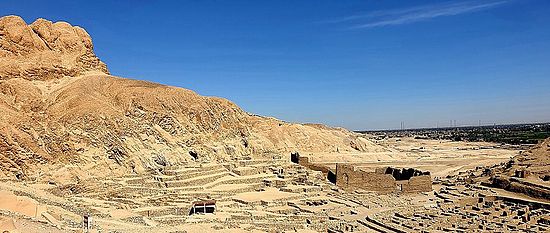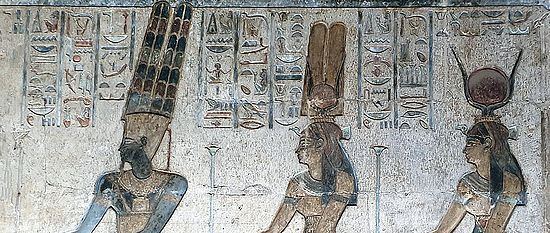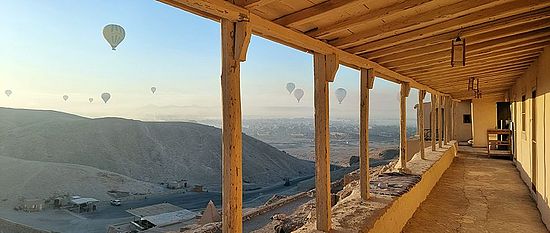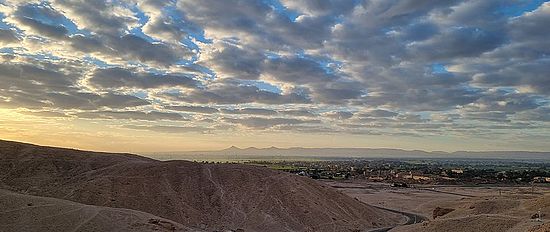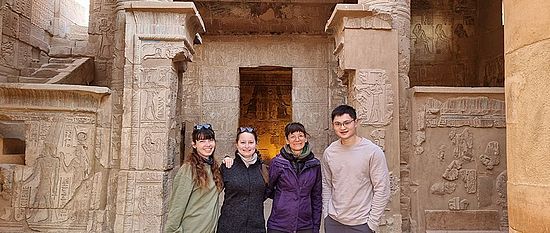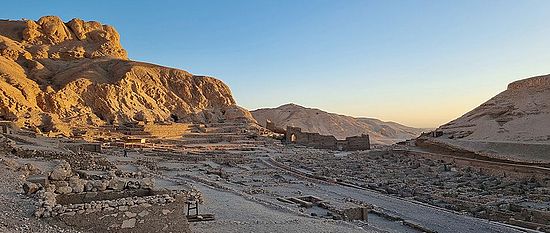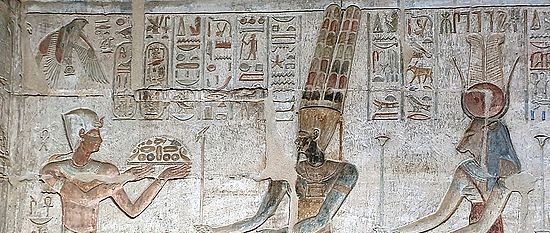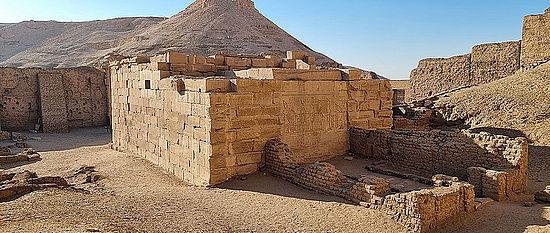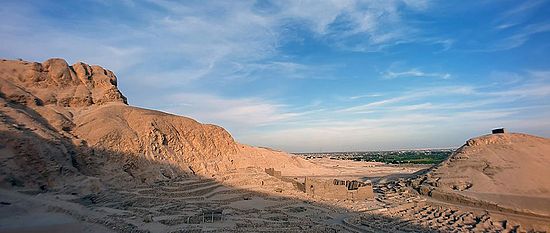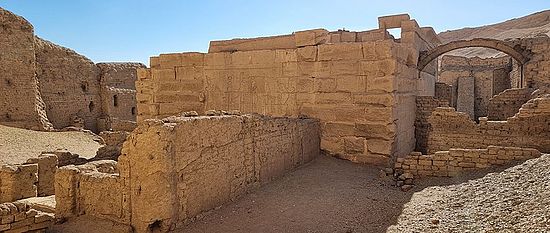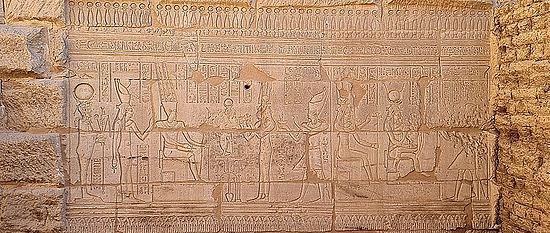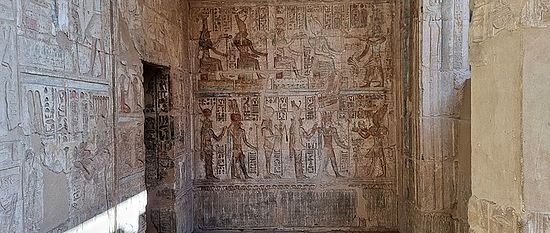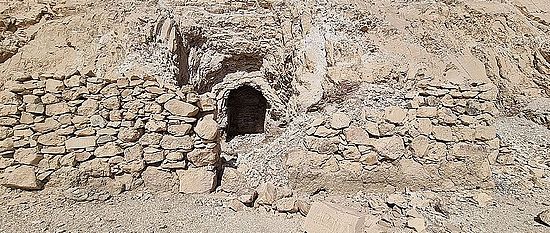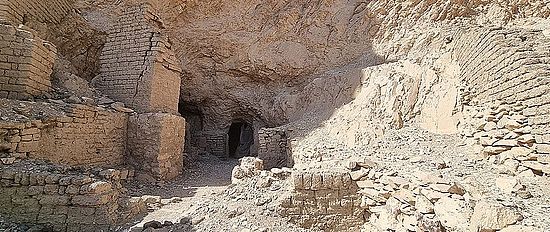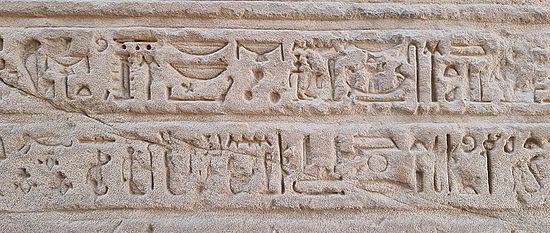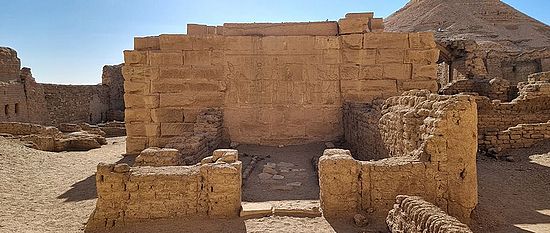Deir el-Medina in the Greco-Roman period
The resumption of research on the Ptolemaic Temple at Deir el-Medina will allow not only the continuation of the historical and architectural study of the building, but also a thorough study of the decorative program, which will include an iconographic, textual and religious analysis, as well as comparisons with other buildings. This work, which began in 2020, is accompanied by a paleographic study of the temple's epigraphy and a study of the well-preserved colors.
This program will be complemented by the study of the Greco-Roman archaeological material found at Deir el-Medina. This will lead to a better understanding of the functioning of the site during this period, reconstruct the context in which the temple was in operation, and examine its role and integration into the cultic landscape on the western shore of Thebes.
Temple research
The hieroglyphic inscriptions of the temple of Deir el Medina were published in the early 2000s, but the building has not been the subject of in-depth study in either its architecture or its theology. The work carried out at the temple aims at a comprehensive study of the temple decoration. This includes, on the one hand, the translation and interpretation of the inscriptions and representations and, on the other hand, the analysis of the content and distribution of the scenes. In addition, a study of the use of colors in the decoration was initiated.
Project Manager
Theology and cult
A detailed study of the gods and goddesses that appear in the temple of Deir el-Medina will make it possible to grasp the nuances of local theology. The study of the genii guarding the temple is already underway.
In addition, documentary sources are being considered to define cults as well as local festivals. Excavation material could also help paint a more reliable picture.
Architektur
An architectural study of the Ptolemaic temple will be carried out by Matthieu Vanpeene. It will allow a better understanding of the construction phases of the building and its particularities.
This collaboration will also allow to start further research on the layout of the temple rooms, which also falls in the field of theology. The so-called mammisi and the small lean-to temple are two additions that deserve further study.
In the long run, the study of the temple at Deir el-Medina will help to investigate the role and use of the small Theban temples on the western bank.
Paleography
The inscriptions of the temple of Deir el-Medina are executed in recessed relief rather than in raised relief, as is often the case with Greco-Roman temples. This fact alone justifies interest in studying the paleography of the temple's hieroglyphs, but the temple also has several rare spellings that should be studied in detail. Several steps are planned to publish a volume devoted to the hieroglyphic signs of the temple of Deir el-Medina:
- Records and drawings of the signs
- Analysis of the shape of the signs
- Comparison with other specimens
- Study of the engraving techniques
- Study of the interactions between text and image
Examination of the archaeological material
The discovery of grave goods from the Greco-Roman period has, with few exceptions, often not attracted much attention. The work is aimed at finding and inventorying the material that still exists.
Part of the research takes place on site at Deir el-Medina with the identification of Greco-Roman funerary objects in the site's magazines and storerooms. Another part takes place in museums and collections around the world.
In addition, an overview of the Greco-Roman burials at Deir el-Medina will be made. For this purpose, it is necessary to determine the location of the tombs that were built or filled in during this period and to reconstruct the documentation.
History of the excavations
In any case, it is useful to trace the history of the excavations, which is of intrinsic interest. It also provides the opportunity to collect valuable information and documentation on the various aspects of the work undertaken.
To this end, several steps were taken: Archival research, review of publications, analysis of Bernard Bruyère's excavation diaries, etc. The results of this research will be useful both for reconstructing the modern history of the temple and for tracing the history of the site and the finds from the Greco-Roman period.
Lectures
« Rediscovering Graeco-Roman Deir el-Medina: Work in Progress ». Vortrag, University College, Oxford (15. Juni 2021)
« Quel devenir pour le site de Deir el-Médina après le Nouvel Empire? ». Vortrag, Société d’égyptologie, Genève, Genf (5. Mai 2021)
« Ornamental and Scriptural Blue. Usage in the Ptolemaic temple of Deir el-Medina and in the local Graeco-Roman Funerary Material ». Internationale Konferenz The Colour Blue in Ancient Egypt and Sudan, Kopenhagen (3.-4. März 2020)
« The “Mammisi” of Deir el-Medina: a Case Study ». Internationale Konferenz Mammisis of Egypt Ist Colloquium, Institut français d’archéologie orientale, Kairo (27.-28. März 2019)
« On some Guardians of the Ptolemaic Temple of Deir el-Medina ». Internationaler Workshop Deir el-Medina through the Kaleidoscope, Turin (8. Oktober 2018)
Publications
Sandrine Vuilleumier, "Ornamental and Scriptural Blue in the Ptolemaic temple of Deir el-Medina", erscheint 2022.
Sandrine Vuilleumier, "Return on the "Mammisi" of Deir el-Medina", erscheint 2022.
Sandrine Vuilleumier, "On some Guardians of the Ptolemaic Temple of Deir el-Medina. A Preliminary Study", published in 2022.
Sandrine Vuilleumier, in Cédric Larcher et al, "Deir el-Medina (2020)", Bulletin archéologique des Écoles françaises à l'étranger, 2021, S. 1-46. https://doi.org/10.4000/baefe.2985.
Team

Project Manager
Team (2022)
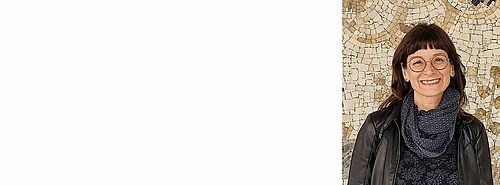
MA Laurence Cappa-Dafflon
Epigraphikerin
Cooperation partners
Dr. Cédric Larcher
Archivist and Head of the French Mission in Deir el-Medina, IFAO
Dr Matthieu Vanpeene
Architect, CCFEETK / CNRS, Luxor
Supporter
This project is carried out in collaboration with the French Mission in Deir el-Medina, directed by the Institut français d'archéologie orientale au Caire (IFAO), and with the Egyptian Ministry of Antiquities. We thank our French and Egyptian colleagues for their trustful collaboration.
In 2020, Sandrine Vuilleumier received the Max Serres Prize of the Ève Delacroix Foundation awarded by the Académie des Inscriptions et Belles-Lettres in Paris to support her work in Deir el-Medina.
Since 2022, the Swiss National Science Foundation (SNSF) has contributed to the funding of the mission.
We thank all participants and sponsors for their support!

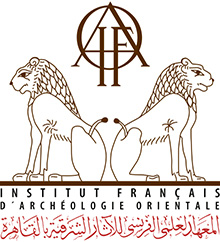

Contact
Project management
Secretariat
The secretariat is open in the morning from 9:00 to 12:00 and on Monday, Thursday and Friday also in the afternoon from 14:00 to 16:00.
Phone: +41 61 267 30 60
Fax: +41 61 267 23 41
Mail:
Contact form
Quick Links

